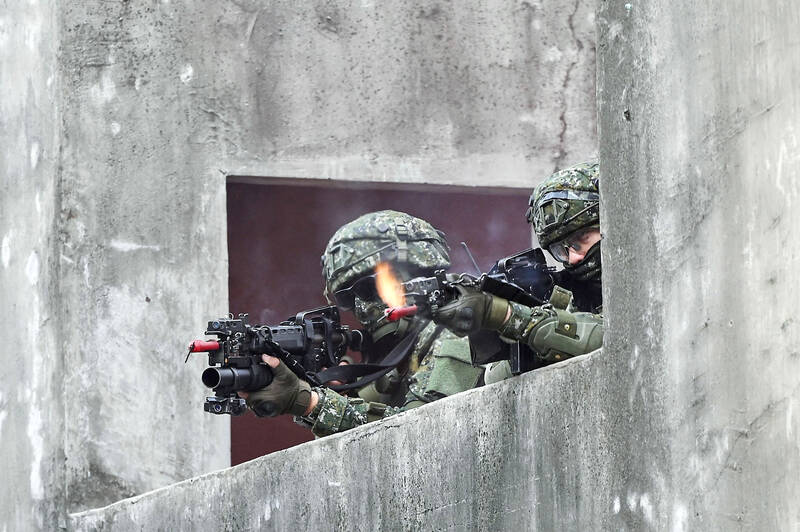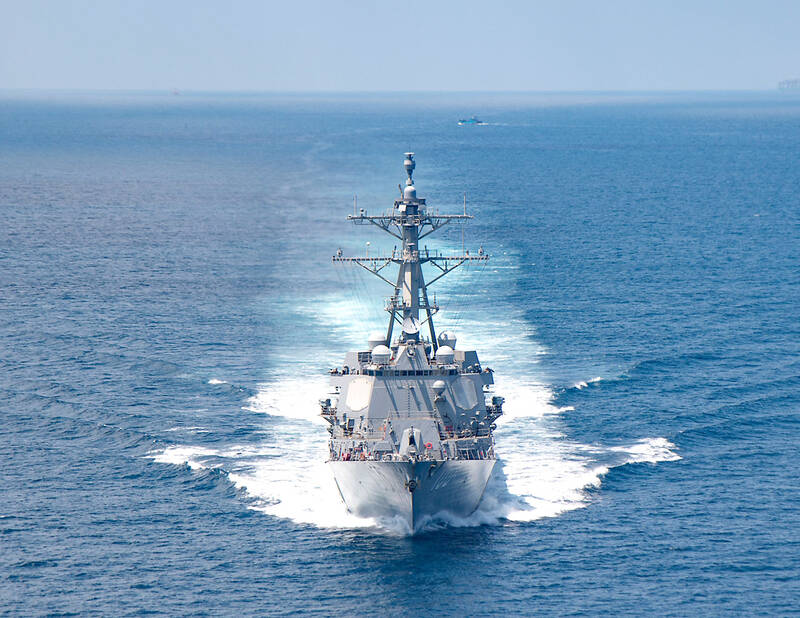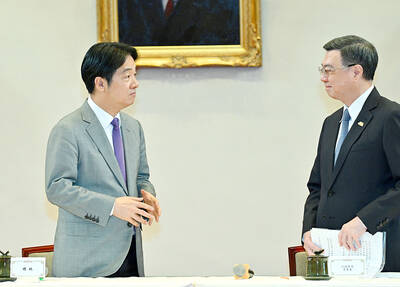Over the years, whole libraries of pro-People’s Republic of China (PRC) texts have been issued by commentators on “the Taiwan problem,” or the PRC’s desire to annex Taiwan.
These documents have a number of features in common. They isolate Taiwan from other areas and issues of PRC expansion. They blame Taiwan’s rhetoric or behavior for PRC actions, particularly pro-Taiwan leadership and behavior. They present the brutal authoritarian state across the Taiwan Strait as conciliatory and rational. Even their historical frames are PRC propaganda.
All of this, and more, colors the latest “analysis” and recommendations from the International Crisis Group, “The Widening Schism across the Taiwan Strait,” which summarizes its message thusly: “The new Taiwanese president has adopted a tougher stance on his country’s autonomy from China. Beijing, in turn, has amped up its pressure on the island.”

Photo: AFP
It recommends that Lai cool his verbiage, while Beijing reduce its military activities.
WHAT SCHISM?
The title signals its pro-PRC position. The idea of a “schism” implies that once there was unity, a pro-PRC framing. There is no “schism” to widen, because the issue is always the PRC’s murderous demand to annex Taiwan, and Taiwanese resistance to it. Nor has Taiwan ever been part of any Chinese state.

Photo: AFP
After casting Tsai as careful and placing Lai in opposition to her, the text states: “Starting in 2021, in response to increasing Chinese pressure, Tsai began to clarify her position further and used the phrase ‘the Republic of China and the People’s Republic of China should not be subordinate to each other,’ implying the two sides are separate, political entities.” That is exactly what Lai said in his inaugural speech.
The Crisis Group argues that Tsai always maintained that the Act Governing the People of the Mainland and Taiwan Areas (台灣地區與大陸地區人民關係條例) would govern her relations with the PRC. According to them, Lai dropped that in his inaugural, making his position more strident than hers.
This claim is nonsensical. Does anyone believe at this point that Tsai actually believed any of that? She was playing a game, as only a skilled bureaucrat can. Moreover, the Crisis Group has to concede the reality that Tsai’s position evolved in response to PRC pressure. What do they think Lai is doing? He is also responding to that increased pressure. Tsai’s “measured” approach, after all, brought no changes in PRC behavior. There is no reason to think that changes in Lai’s rhetoric will result in changes in PRC behavior, either. What should Lai do?
In fact, the Crisis Group affirms all this, but points out that the reason to return to Tsai’s measured approach is not to mollify the PRC, but because it won support from other nations. Yet other nations have moved closer to Taiwan and the US because they are increasingly perceiving a shared threat from the PRC. Do the writers of that document really imagine that sovereign nations altered their policies toward the PRC because Tsai was nice? Note that Lai’s allegedly more strident rhetoric has not cooled this trend.
The Crisis Group even contends that Chinese leader Xi Jinping (習近平) was more flexible prior to Lai’s inaugural, saying that Taiwan must recognize that “both sides of the Taiwan Strait are Chinese and one family.” This was not “vaguer language” as the Crisis Group claims. The key word there is not “family” but “Chinese.” Xi’s words are merely the bogus “1992 consensus” refashioned, more of the same old inflexibility. But by presenting this tired war threat as “flexible,” the document can then argue that Taiwan’s resistance is the cause of the PRC’s tension heightening.
STATUS QUO
The report then goes on to recommend that everyone return to the old status quo, a movement that is no longer possible because the size of the PRC military has destroyed the ability of the US navy to enforce the old status quo. It even states: “At the same time, Washington must also continue to reassure Beijing that the US remains committed to acting in accordance with its one China policy.”
This “reassuring” is never defined, because people who write about the one-China policy without defining it typically hope the US will hand over Taiwan to Beijing. But as readers know, the US one-China policy is that the PRC is a state on the Asian mainland, which Taiwan is not part of. How, then, could it be reassuring to Beijing to hear the US say this? The writer is counting on the ignorance of the reader to fill in the blanks with the hazy idea that the US position is that Taiwan is part of the PRC.
The danger of this and the many other pieces like it is not only its pro-PRC coloring, but the American rhetorical context into which such texts fit. On the one hand, there is the never-ending flow of pro-PRC effluent in the US-China discourse. On the other, there is the crowd that argues that Taiwan should be abandoned to its fate. Somewhere in between is the extreme center, which ostensibly argues that Taiwan should do more in its own defense, but actually implies that since it probably won’t, it would be morally acceptable to not defend Taiwan.
Ironically, like the extreme center crowd, the Crisis Group calls on Washington to press Taipei to do more in its own defense, but makes no concrete recommendations for US actions, such as pre-positioning weapons, making firm commitments to defend the island, increasing military training and other military cooperation, and so forth. The Crisis Group’s vague verbiage on US actions betrays the pro-PRC positioning of the writers — such moves would make it more difficult for the PRC to take Taiwan. Instead, the writers call on the US to reassure Beijing that it remains open to peaceful “unification” (has that move ever changed Beijing’s behavior?).
Indeed, the document shows how the Crisis Group’s position that Taiwan must tone down its rhetoric and the extreme center claim that Taiwan should do more in its own defense (or be abandoned) are simply parallel variants of the “it’s Taiwan’s fault” position. It’s the reinforcing effect of these two positions, which are seemingly orthogonal to each other, that is so dangerous.
As in all pro-PRC documents, Beijing is never tasked with making concrete reductions in its expansionism — indeed, the idea that the PRC is an expansionist state whose demand for Taiwan is part of a larger expansionist drive never appears in this document. Yet everyone making policy in Tokyo, Manila, Seoul and Washington must grapple with that fact.
“Peace in the Taiwan Strait,” say the writers, “has for decades rested on a concerted willingness among Washington, Beijing and Taipei to set aside and paper over long-standing differences related to Taiwan’s sovereignty.”
No, peace in the Taiwan Strait has not rested on “willingness” — with its implication that “unwillingness” (especially on Taiwan’s part, of course) will lead to war. It has rested on the US navy’s ability to crush the PRC in a general war. It is not a coincidence that as that ability has eroded, peace is increasingly seen as threatened.
Notes from Central Taiwan is a column written by long-term resident Michael Turton, who provides incisive commentary informed by three decades of living in and writing about his adoptive country. The views expressed here are his own.

Under pressure, President William Lai (賴清德) has enacted his first cabinet reshuffle. Whether it will be enough to staunch the bleeding remains to be seen. Cabinet members in the Executive Yuan almost always end up as sacrificial lambs, especially those appointed early in a president’s term. When presidents are under pressure, the cabinet is reshuffled. This is not unique to any party or president; this is the custom. This is the case in many democracies, especially parliamentary ones. In Taiwan, constitutionally the president presides over the heads of the five branches of government, each of which is confusingly translated as “president”

Sept. 1 to Sept. 7 In 1899, Kozaburo Hirai became the first documented Japanese to wed a Taiwanese under colonial rule. The soldier was partly motivated by the government’s policy of assimilating the Taiwanese population through intermarriage. While his friends and family disapproved and even mocked him, the marriage endured. By 1930, when his story appeared in Tales of Virtuous Deeds in Taiwan, Hirai had settled in his wife’s rural Changhua hometown, farming the land and integrating into local society. Similarly, Aiko Fujii, who married into the prominent Wufeng Lin Family (霧峰林家) in 1927, quickly learned Hoklo (commonly known as Taiwanese) and

The low voter turnout for the referendum on Aug. 23 shows that many Taiwanese are apathetic about nuclear energy, but there are long-term energy stakes involved that the public needs to grasp Taiwan faces an energy trilemma: soaring AI-driven demand, pressure to cut carbon and reliance on fragile fuel imports. But the nuclear referendum on Aug. 23 showed how little this registered with voters, many of whom neither see the long game nor grasp the stakes. Volunteer referendum worker Vivian Chen (陳薇安) put it bluntly: “I’ve seen many people asking what they’re voting for when they arrive to vote. They cast their vote without even doing any research.” Imagine Taiwanese voters invited to a poker table. The bet looked simple — yes or no — yet most never showed. More than two-thirds of those

In the run-up to the referendum on re-opening Pingtung County’s Ma-anshan Nuclear Power Plant last month, the media inundated us with explainers. A favorite factoid of the international media, endlessly recycled, was that Taiwan has no energy reserves for a blockade, thus necessitating re-opening the nuclear plants. As presented by the Chinese-language CommonWealth Magazine, it runs: “According to the US Department of Commerce International Trade Administration, 97.73 percent of Taiwan’s energy is imported, and estimates are that Taiwan has only 11 days of reserves available in the event of a blockade.” This factoid is not an outright lie — that